
Heroes of Iwo Jima
 |
 |
One-third of all Marines killed in World War II were killed on Iwo Jima.
 |
There were actually two flag-raisings that day on Iwo Jima.
 |
The man who took the best known of the photos.
 |
The photo was of major psychological uplift value to the Americans.
 |
The photo and statues made from it helped raise a lot of money.
 |
There was also some controversy about the photo. Some people charged that the photo had been posed.
 |
The best-known flag raising was actually two hours after the first flag had been raised.
 |
The video goes into the histories of the men who raised the flags.
 |
One of the men was a Native American of the Pima tribe.
 |
 |
Mt. Suibachi, an extinct volcano. There is where the flags were raised.
 |
 |
The Japanese used a system of interconnected caves. This would allow them to avoid being killed by sea or air bombardment, and to move freely between various places.
Inside one of the tunnels.
 |
The idea wasn't to defeat the Americans, but to make the cost of taking the island very high. Each Japanese was supposed to kill ten Americans before he was, in turn, killed.
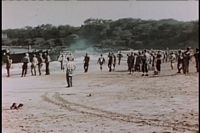 |
The film also goes into how the men were trained for the invasion of Iwo Jima.
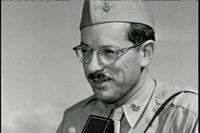 |
Joe Rosenthal. There were some ninety Marine photographers involved in recording what happened during the invasion.
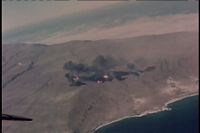 |
The island was bombed for two and a half months before the invasion.
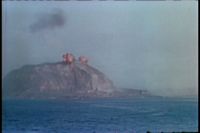 |
Unlike in the present day, where things like invasions are covered live, the video says the invasion of Iwo Jima was, at first, not announced.
 |
Over 400 boats were involved in the invasion.
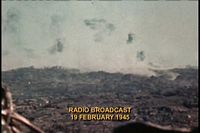 |
The video includes a radio broadcast from the scene of the battle.
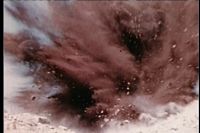 |
The Japanese waited until the Marines were on the beach before opening fire.
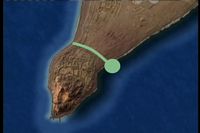 |
Although the fighting was vicious, the lead battalion managed to cut across the island in about an hour and a half. From another source I have read: there was supposed to be a tunnel from Suribachi up to the north, but the Japanese didn't have time to finish it. If they had, things could have been even worse.
 |
Flamethrowers were used in the cave-to-cave fighting.
 |
There was a 35% casualty rate by D +3.
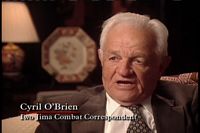 |
A group of marines was told to climb the mountain and secure it, and if they made it to the top, to raise the flag. Not when, but if.
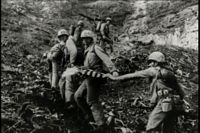 |
There are a lot of black-and-white stills of the climbing of the mountain.
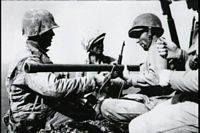 |
An old Japanese water pipe was used for the raising of the first flag.
 |
The first flag flies over the mountain.
 |
There was a major positive reaction when the Marines saw the flag flying.
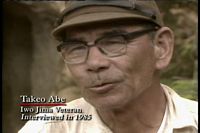 |
A Japanese soldier says, once he saw the flag, then, from that point on, he had no idea what was in store for Japan.
 |
The video goes into a description of why a second flag was ordered raised.
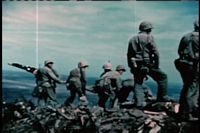 |
The start of the raising of the second flag.
 |
 |
The video then shows how the photo was developed and sent to the states. Then the video goes into more of the controversy about the picture.
 |
Half the guys who raised both of the flags were killed on the island.
One-by-one the flag raisers are killed in battle. Then a damaged B-29 lands on the not-totally-complete runway, proving the value of taking the island.
Among other damage is the loss of much of this engine.
20,000 of 21,000 Japanese had been killed, and the Americans lost around 7000 dead.
An ad for victory bonds.
So the survivors of the flag-raising as used in publicity tours for the war bond drive. They didn't feel like heroes, though; they felt they were just doing their jobs.
The goal of the loan drive was $14 billion, but it actually raised some $26 billion.
The film then makes reference to the dropping of the atomic bombs.
The men involved in the flag raising were in the film.
The film then goes into the lives of the men after the war was over.
Tony Curtis in The Outsider, a movie about Ira Hayes, one of the flag-raisers. The film goes on to talk about the other men and what happened to them, and how they died.
Iwo Jima was returned to Japan and is now a Japanese military base.
A shrine where the flag had flown.
Main Index
Japan main page
Japanese-American Internment Camps index page
Japan and World War II index page
|
|